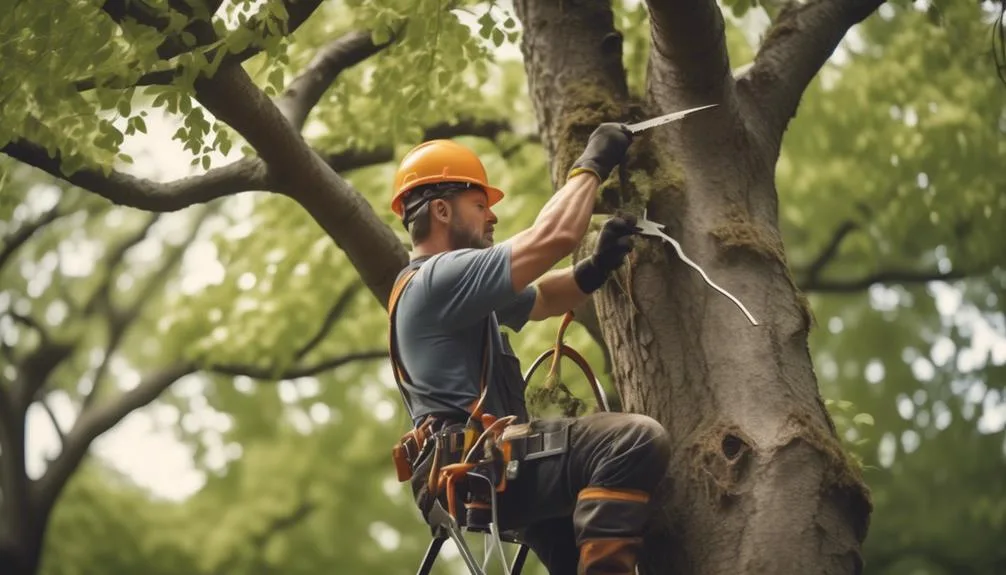Are you facing the challenge of pruning your overgrown elm tree? Knowing the right techniques for this task is crucial for the tree's health and your landscape's beauty.
From the timing of the pruning to the specific tools and techniques required, there's much to learn. Whether you're an experienced gardener or new to tree care, mastering the art of pruning elms can make a significant difference in maintaining these majestic trees.
Timing for Pruning Elm Trees
When considering the timing for pruning elm trees, it's essential to assess the health and growth patterns of the tree to determine the most appropriate time for this crucial maintenance task. Best practices dictate that the ideal time for pruning elm trees is during late winter or early spring while the tree is still dormant. This timing allows for the tree to heal quickly and minimizes stress on the tree.
Avoid pruning during the summer as it can make the tree vulnerable to diseases such as Dutch elm disease. Seasonal considerations play a significant role in determining the right time for pruning.
Tools Needed for Pruning Elm Trees
To properly prune elm trees, you will need a set of sharp pruning shears or loppers, a handsaw for thicker branches, and protective gear such as gloves and safety glasses. Safety precautions are essential when pruning elm trees, as the branches can be heavy and potentially hazardous. Here's a list of the necessary tools and protective gear for pruning elm trees:
| Tools | Description | Purpose |
|---|---|---|
| Pruning Shears | Sharp cutting blades | Trim small branches and twigs |
| Loppers | Extendable handles, sharp blades | Cut thicker branches |
| Handsaw | Toothed blade, sturdy handle | Remove thicker limbs |
Remember to wear safety glasses and gloves to protect your eyes and hands while pruning. Following these safety precautions and proper pruning techniques will ensure the task is completed safely and effectively.
Techniques for Pruning Elm Trees
Pruning elm trees requires mastering specific techniques to effectively utilize the tools and protective gear mentioned previously. Proper pruning is essential for maintaining the health and longevity of elm trees.
Start by removing dead or diseased branches, cutting them back to the collar without damaging the trunk. This technique helps prevent the spread of diseases and encourages new growth.
Additionally, thin out crowded branches to improve air circulation and sunlight penetration, promoting overall tree health. When pruning, make clean cuts at a slight angle just above a bud or lateral branch to encourage proper healing.
Remember to step back periodically to assess the tree's overall shape and balance. These techniques are vital for elm tree maintenance, ensuring they remain strong, healthy, and beautiful for years to come.
Pruning Cuts for Elm Trees
Consider using a sharp pruning tool to make clean cuts at a slight angle just above a bud or lateral branch, as this encourages proper healing and growth for your elm trees.
When making pruning cuts for elm trees, it's important to keep in mind the following:
- Branch angle: Ensure that the angle of your cuts promotes the natural form and structure of the tree, preventing weak or awkward growth patterns.
- Disease prevention: Make sure to sterilize your pruning tools between cuts to prevent the spread of diseases and infections.
- Smooth edges: Aim for smooth, clean cuts to aid in the healing process and reduce the risk of pests and diseases entering through jagged edges.
- Strategic pruning: Focus on removing dead or diseased branches, as well as those that cross or rub against each other to promote overall tree health.
- Regular maintenance: Schedule regular pruning sessions to maintain the shape and health of your elm trees.
Aftercare for Pruned Elm Trees
After pruning your elm trees, it's essential to provide proper aftercare to support their recovery and promote healthy regrowth.
Establish a regular watering schedule for the first two years post-pruning. Water deeply, allowing the soil to dry slightly between watering to encourage deep root growth and reduce the risk of disease. Aim for about 1-1.5 inches of water per week, adjusting based on rainfall and temperature.
Additionally, monitor the trees for signs of disease, such as wilting, yellowing leaves, or unusual growths. Promptly address any issues to prevent the spread of diseases and ensure the trees can focus on regrowth.
Conclusion
Mastering the art of pruning elm trees ensures their vitality and allure. By applying the right techniques, timing, and care, you can nurture a well-maintained and flourishing elm tree.
Remember, the health of your tree hinges on clean cuts and attentive aftercare. With these principles at heart, your elm trees will stand as a testament to thoughtful tending.
Happy pruning!

My interest in trees started when I first saw the giant sequoias in Yosemite.
I was a teenager then, and I remember thinking, “I need to learn more about this.”
That moment stuck with me.
A few years later, I went on to study forestry at Michigan Tech.
Since graduating, I’ve worked in a mix of hands-on tree care and community education.
I’ve spent over ten years helping people understand how to plant, maintain, and protect the trees in their neighborhoods.
I don’t see trees as just part of the landscape.
They are living things that make a real difference in our daily lives.
